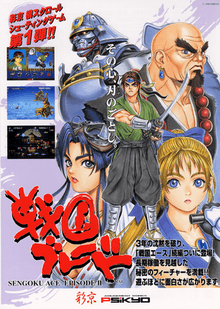Sengoku Blade: Sengoku Ace Episode II
| Sengoku Blade | |
|---|---|
 Japanese arcade flyer | |
| Developer(s) | Psikyo |
| Publisher(s) | Taito (PS2) |
| Designer(s) | Hirofumi Nakamura |
| Artist(s) | Tsukasa Jun |
| Composer(s) | Masaki Izutani |
| Series | Sengoku Ace |
| Platform(s) | Arcade, Sega Saturn, PlayStation 2 |
| Release date(s) | 1996 (Arcade) November 22, 1996 (SS) December 2, 2004 (PS2) |
| Genre(s) | Scrolling shooter |
| Mode(s) | Single player, two-player co-op |
| Distribution | CD-ROM |
| Cabinet | Horizontal |
Sengoku Blade: Sengoku Ace Episode II, originally released in Japan as Tengai (戦国ブレード), is a horizontally scrolling shoot 'em up video game released for arcade machines in 1996 by Psikyo as a sequel to the 1993 shooter Sengoku Ace. It was later released as a part of Psikyo Shooting Collection Vol. 2: Sengoku Ace & Sengoku Blade for the PlayStation 2.
The game is set in a historical fantasy version of the Sengoku period of Japanese history, featuring demons, magic and steam-powered robotics. It was followed by Sengoku Cannon: Sengoku Ace Episode III, released for the PlayStation Portable in 2005.
Gameplay
Sengoku Blade marked a complete breakout of the Sengoku Ace series from the classic Sonic Wings-style system (the first Sengoku Ace was still scrolled vertically), but this time with a much more complex gameplay system in which the player characters fly around on the screen by themselves instead of piloting various aircraft, in a way similar to the 1997 Psikyo game Sol Divide.[1] Episode II was noticeably harder than its predecessor, and featured much better 2-D graphics, including (for its time) impressive parallax scrolling effects and detailed and well-animated characters and backgrounds. Just like the previous game, the sequel features multiple endings, different for various characters, as well as branching paths for the different sets of levels.
Characters
- Tengai (Tengai Kano) (ターボ坊主 天外) - a Buddhist warrior-monk from the previous game, who has become the main character in the sequel. Voiced by Shōzō Iizuka.
- Miko / Koyori (Koyori Togashi) (富樫こより) - a busty Shinto shrine girl maiden. She has become the series' symbol and a fan favourite due to her increased sex appeal in comparison to the original game. Voiced by Maria Kawamura.
- Junis (Junis Hayate) (ユーニス) - a spunky 12-year old ninja girl with a pet lemur or tarsier named Socrates; she is the younger sister of Jane from Sengoku Ace. (Jane had disappeared at the end of the previous game, but Junis believes that she is alive and imprisoned at the Evil Castle.) Voiced by Hiroko Kasahara.
- Sho / Shoma (Shoumaru) (翔丸) - a young swordsman ninja who is in love with the kidnapped princess Futsu and - although feels some crush with Koyori[2] - wants revenge for the death of his mother and sisters.[3] During the game, it is revealed that his father is the lord of evil, Kiyatsu (the final boss of the game). Voiced by Takehito Koyasu.
- Katana / Hagane (ハガネ) - a samurai robot attempting recover its human body. Katana is really a swordswoman called Hagane and during his ending with Junis, she reveals her first name: Kirie. Voiced by Hōchū Ōtsuka.
- Flush (Flash) / Ayin (Shine-Ain) / Kain / Aine (せんこうのャイン) - a one-eyed archer samurai from the previous game, now as a secret character, who is looking for his sister Asuka again. Voiced by Norio Wakamoto.
The characters were designed by the now-famous Tsukasa Jun (Tsukasa Kiyoshi, at that time still an "underground" artist), based on the works of Hirofumi Nakamura in the original game. Tsukasa also returned to design the characters for the second sequel.
Release
Originally released for the arcades in 1996, Sengoku Blade was first ported to the Sega Saturn on November 22 of that same year.[4] This version was released as a two-disc double set, including a bonus omake disc which featured hundreds of Sengoku Ace series artworks (including the official art, guest art, and fan art from a contest by Psikyo), and now is rare and expensive to obtain. Exclusive for the Saturn conversion was the implementation of voices during the brief cutscenes, and the addition of Marion from Gunbird series (voiced by Chiharu Tanaka) as a bonus hidden character.[5]
A manga adaptation was published on August 4, 1996.[6] The game's original soundtrack was released by Pony Canyon and Scitron on May 17, 1996.[7] Several PVC figures were also released for Koyori and Junis, as well as for the demon ninja villainess named Kaen (火燕), one of boss characters who was also of the game's mascot characters.[4]
On December 2, 2004, the game was also ported to PlayStation 2 as part of the Psikyo Shooting Collection Vol. 2: Sengoku Ace & Sengoku Blade by Taito, which too was re-released one year later as a budget-range title. The Japanese release contains both Sengoku Ace and Sengoku Blade, but in Europe the two games were sold separately.[4]
Reception
According to gamesTM, "Sengoku Blade was quite a departure for Psikyo as it marked the firs time the developer had created a horizontally scrolling shooter. Fortunately, it got everything right and delivered a great game that's highly reminiscent of its Gunbird series."[8] The game's version of Koyori was ranked as the 38th best looking game girl by GameHall's Portal PlayGame in 2014.[9]
References
- ↑ "Sol Divide - Videogame by Psikyo - International Arcade Museum". Arcade-museum.com. Retrieved 2013-09-11.
- ↑ "Ending for Tengai-Sho, Miko Team(Arcade)". Vgmuseum.com. Retrieved 2013-09-11.
- ↑ "long range bullet: Tsukasa Jun: Game Contributions". Longrangebullet.namakoteam.com. 2004-04-29. Retrieved 2013-09-11.
- ↑ 4.0 4.1 4.2 "Sengoku Blade". Arcade Gear. Retrieved 2014-05-04.
- ↑ "Sengoku Blade Koyori & Marion translated dialogues (Sega Saturn)". YouTube. 2010-12-29. Retrieved 2013-09-11.
- ↑ "刃−Yaiba−". Interq.or.jp. Retrieved 2014-05-04.
- ↑ "PCCB-00216 | Sengoku Blade". VGMdb. Retrieved 2013-09-11.
- ↑ "gamesTM 27". Archive.org. Retrieved 2014-05-04.
- ↑ http://portalplaygame.com/top-100-as-personagens-mais-gatas-dos-games/